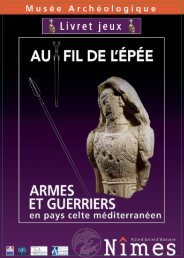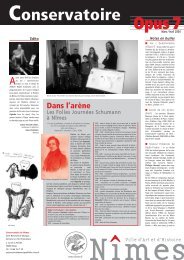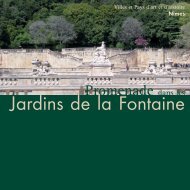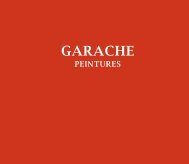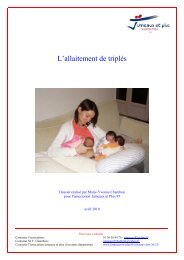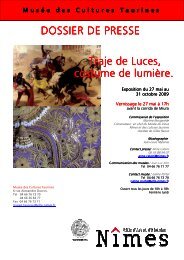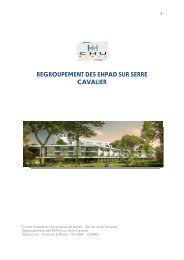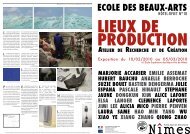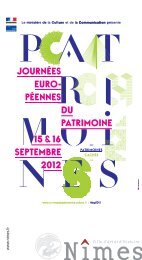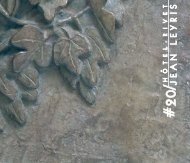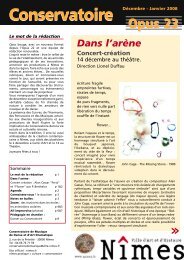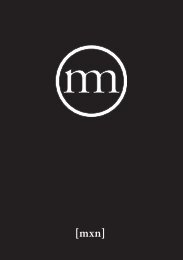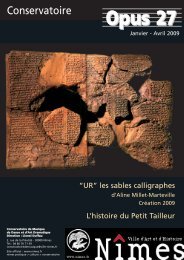.Presentation of the school - Nîmes
.Presentation of the school - Nîmes
.Presentation of the school - Nîmes
You also want an ePaper? Increase the reach of your titles
YUMPU automatically turns print PDFs into web optimized ePapers that Google loves.
72<br />
E.S.B.A.N. teaching staff<br />
Augustin PINEAU<br />
augustin.pineau.free.fr + venusdailleurs.fr + artistelr.fr<br />
Born in Bordeaux in 1968, lives and works in Nîmes<br />
‘The duty <strong>of</strong> <strong>the</strong> right eye is to look through <strong>the</strong> telescope while <strong>the</strong> left<br />
eye questions <strong>the</strong> microscope.’ 1<br />
‘How to convert thinking into images and an image into memory; how<br />
to reduce <strong>the</strong> world to a finished set <strong>of</strong> representations and change all<br />
knowledge into a show.’ 2<br />
In art, images are too <strong>of</strong>ten designed from <strong>the</strong>ir perception, forgetting<br />
that <strong>the</strong>ir handling involves <strong>the</strong> whole <strong>of</strong> <strong>the</strong> ‘psyche’ at <strong>the</strong> level <strong>of</strong><br />
memory… Mnemosyne was <strong>the</strong> mo<strong>the</strong>r <strong>of</strong> <strong>the</strong> Muses in Greeks<br />
mythology. The mnemonic technique developed strongly in <strong>the</strong> sixteenth<br />
century by Giulio Camillo in Teatro della Memoria may seem to us today<br />
to be an anachronistic curiosity unless it is seen in its context. In The Art<br />
<strong>of</strong> Memory, Frances A. Yates made an inventory <strong>of</strong> <strong>the</strong> attempts made<br />
at classification from Ancient Greece and Rome until <strong>the</strong> Renaissance<br />
and she reminded us that what stimulated Renaissance interest in occult<br />
memory was <strong>the</strong> Hermetic tradition <strong>of</strong> <strong>the</strong> Renaissance itself 3 . However,<br />
here it is about a quest for things that are hidden or even invisible, one <strong>of</strong><br />
<strong>the</strong> inherent dimensions <strong>of</strong> art, in <strong>the</strong> manner <strong>of</strong> a cryptogram.’<br />
Théâtres de la mémoire<br />
Bertrand Meyer-Himh<strong>of</strong>f<br />
‘Collage is explored to within its tiniest nooks and crannies. First, printed<br />
images accumulate in a studio, but not just any old images. There<br />
is a collector’s logic in <strong>the</strong> quest for <strong>the</strong>m, in <strong>the</strong> chance <strong>of</strong> meeting<br />
<strong>the</strong>m and in <strong>the</strong>ir classification. The work gains meaning little by<br />
little according to <strong>the</strong> laws <strong>of</strong> relative etymology during its assembly,<br />
following a very personal chain <strong>of</strong> association, by resonance and not by<br />
matching. Everything finally fits and is adjusted. Augustin Pineau likes<br />
packs <strong>of</strong> cards, boxes <strong>of</strong> games—snakes and ladders or Pope Joan. He<br />
sometimes recycles older collages. Each work is a meticulous miniature.<br />
Every detail is justified by juxtaposition with ano<strong>the</strong>r to give a new,<br />
significant general figure. The principle is that <strong>of</strong> a mythological bestiary<br />
that is universal or personal for <strong>the</strong> artist in which men and animals<br />
merge, that <strong>of</strong> <strong>the</strong> mythical figures that made a lasting impression during<br />
our childhood or <strong>the</strong> more scholarly bestiary <strong>of</strong> heraldry. The collages<br />
are carnivals <strong>of</strong> objects, constellations <strong>of</strong> instants, travel boxes (generic<br />
titles). Call can be made on Raymond Roussel for <strong>the</strong> process, Marcel<br />
Duchamp for his ‘Célibataire’ machines and his taste for jokes but why<br />
not <strong>the</strong> Joyce <strong>of</strong> Finnegans Wake… We are in and remain in a coherent<br />
plastic universe where, in spite <strong>of</strong> fragmentation, syn<strong>the</strong>tic unity wins<br />
over chaos. Augustin Pineau’s reconstituted images function like ours;<br />
<strong>the</strong>y are books <strong>of</strong> spells (spelling) in which you have to put <strong>the</strong> puzzle<br />
toge<strong>the</strong>r by reassembling <strong>the</strong> pieces to know who we are and possibly<br />
find out how to interpret dreams …’<br />
Le parapluie de tournesol ou le piment rouge<br />
Bertrand Meyer-Himh<strong>of</strong>f<br />
1 Léonora Carrington<br />
2 Bertrand Schefer, préface, " le théâtre de la mémoire " Guilio Camillo ed Allia 2001<br />
3 F. A. Yates, The Art <strong>of</strong> Memory, Routledge and Kegan Paul, London, 1966<br />
le bouchon d’épouvante<br />
Collage<br />
46,3 x 29,5 cm



